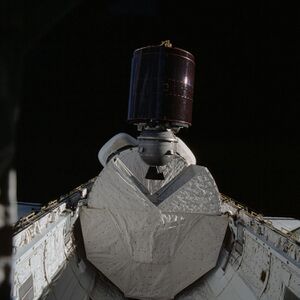Engineering:SBS 3 (satellite)
 SBS 3 with PAM-D stage | |
| Mission type | Communications |
|---|---|
| Operator | SBS |
| COSPAR ID | 1982-110B[1] |
| SATCAT no. | 13651 |
| Mission duration | 12 years, 6 months and 21 days (achieved) 41 years, 8 months, 9 days (in orbit) |
| Spacecraft properties | |
| Bus | HS-376 |
| Manufacturer | Hughes Space and Communications |
| Launch mass | 1,117 kilograms (2,463 lb) |
| Start of mission | |
| Launch date | 11 November 1982, 12:19 UTC |
| Rocket | Space Shuttle Columbia STS-5 |
| Launch site | Kennedy LC-39A |
| Contractor | NASA |
| End of mission | |
| Disposal | Decommissioned |
| Deactivated | June 02, 1995 |
| Orbital parameters | |
| Reference system | Geocentric |
| Regime | Geostationary |
| Longitude | 94° W[2] |
| Eccentricity | 0.73391 |
| Perigee altitude | 294 kilometres (183 mi) |
| Apogee altitude | 37,127 kilometres (23,070 mi) |
| Inclination | 23.7° |
| Period | 659.1 minutes |
| Epoch | November 11, 1982 |
| Transponders | |
| Band | 14 Ku band |
SBS 3 was a geostationary communications satellite designed and manufactured by Hughes (now Boeing) on the HS-376 platform. It was ordered by Satellite Business Systems, which later sold it to Hughes Communications. It had a Ku band payload and operated on the 94°W longitude.[3]
Satellite description
The spacecraft was designed and manufactured by Hughes on the HS-376 satellite bus. It had a launch mass of 1,117 kg (2,463 lb), a geostationary orbit and a 7-year design life.[4]
History
On November 11, 1982, SBS 3 was finally launched by a Space Shuttle Columbia in the mission STS-5 from Kennedy Space Center at 12:19 UTC. The satellite was launched along with the Canada communications satellite Anik C3.
On 2 June 1995, SBS 3 was finally decommissioned and put on a graveyard orbit.[3]
See also
- 1982 in spaceflight
References
- ↑ "SBS 3". NASA Space Science Data Coordinated Archive. https://nssdc.gsfc.nasa.gov/nmc/spacecraft/display.action?id=1982-110B.
- ↑ "SBS 3". n2yo.com. http://www.n2yo.com/?s=13651.
- ↑ 3.0 3.1 Krebs, Gunter Dirk. "SBS 1, 2, 3, 4, 5 / HGS 5 - Gunter's Space Page". http://space.skyrocket.de/doc_sdat/sbs-1.htm.
- ↑ "SBS 3". NASA Space Science Data Coordinated Archive. https://nssdc.gsfc.nasa.gov/nmc/spacecraft/display.action?id=1982-110B.
 |

